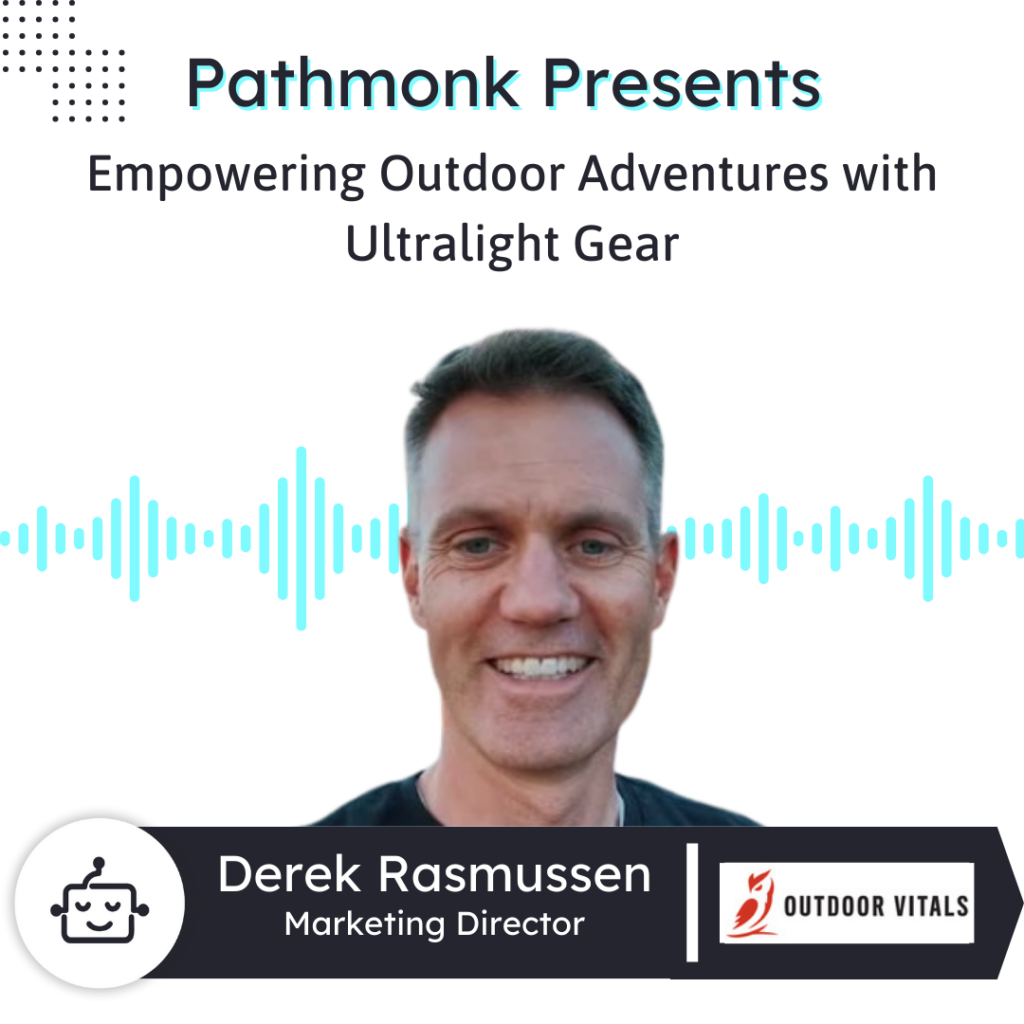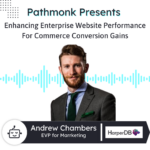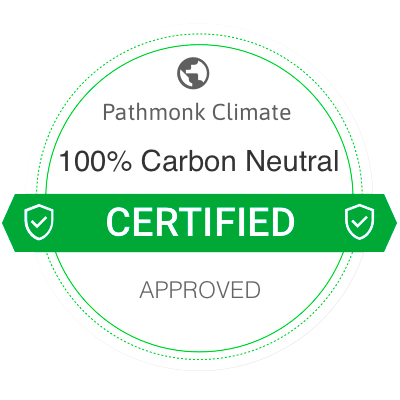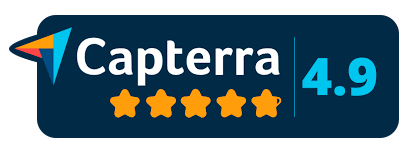
Introduction
Join Pathmonk Presents as we talk with Derek Rasmussen, Marketing Director at Outdoor Vitals, a company crafting ultralight, performance-driven gear for backpackers.
Derek shares how they target ultralight enthusiasts and through-hikers, solving the need for reliable, high-quality equipment. Learn about their top acquisition channel—paid advertising through strategic giveaways on Meta and Google—paired with Klaviyo email follow-ups.
Discover their organic efforts via podcasts and YouTube, plus their unique approach to product testing in the backcountry. Derek’s insights on focusing on KPIs and avoiding vanity metrics offer actionable tips for e-commerce marketers aiming to drive growth.
Tune in!
Increase +180%
leads
demos
sales
bookings
from your website with AI
Get more conversions from your existing website traffic delivering personalized experiences.

Rick: Pathmonk is the AI for website conversions. With increasing online competition, over 98% of website visitors don’t convert. The ability to successfully show your value proposition, and support visitors in the buying journey separates you from the competition online. Pathmonk qualifies to converts leads on your website by figuring out where they are in the buying journey and influencing them in key decision moments with relevant micro experiences like case studies, intro videos, and much more. Stay relevant to your visitors and increase conversion by 50% by adding Pathmonk to your website in seconds, letting the artificial intelligence do all the work and increase conversions while you keep doing alright.
Welcome to today’s episode of Pathmonk Presents everyone. Let’s talk about today’s guest today. We are joined by Derek Rasmussen. He is the Marketing Director at Outdoor Vitals. Derek, welcome to the show.
Derek Rasmussen: Hey, thanks. Yeah, I’m happy to be here.
Rick: Of course. Let’s start with the basics, Derek. What’s the big idea behind Outdoor Vitals and, if you were explaining it to a friend over coffee, how would you describe what you do?
Derek Rasmussen: So Outdoor Vitals—we are an outdoor gear company. We design ultralight performance gear for the backcountry. What that means is, we focus on backpacking gear, and obviously that’s gotta be as lightweight as possible to be as comfortable as possible, but we don’t believe that weight is the only—or necessarily the number one—factor in performance. So we focus on performance first. Performance-first, ultralight gear. Our big mantra is getting people outside. We just want to help people have gear that performs, that they can be confident in, and that really enables them to spend more time outdoors. We truly believe that any person, if you spend time outdoors, it’ll help you mentally, emotionally, physically—and that’s what we’re about: just helping people do that.
Rick: That’s a really good message. I think we don’t spend as much time outdoors now. Unrelated but somewhat related, I think there’s a study I just heard about today listening to a podcast—that kids these days get as much, if not less, outdoor time or time playing outside as prisoners in jail. That’s worrying, and I think companies like yours are actually spreading the message: get out. So that’s great.
Yeah, exactly. I think it’s a great message. I’m curious which type of customers are the best fit for your product? Obviously, there’s the outdoor type—I think that fits within that—but what kind of, I guess in a way, key problems do you help them solve? Or how does that impact their shopping experience?
Derek Rasmussen: There are a couple of products that we have that appeal to outdoor enthusiasts in general, but our specific niche is ultralight backpackers. We have a lot of different product lines—from ultralight apparel to tents to backpacks to sleeping bags—and all of it is a little bit higher-end. So typically, the best customer for our gear is someone spending a decent amount of time in the backcountry, hiking and backpacking. They’re willing to spend a little bit more to have gear that truly performs.
For a lot of people, if you’re only going out once or twice a year on a weekend camping trip, some of the gear you might find at the local big box store is gonna be good enough—and it’s typically lower-priced. But our stuff is very performance-driven for backcountry athletes, ultralight backpackers, thru-hikers—guys that are taking four to six months off out of the year just to thru-hike the Appalachian Trail or the Pacific Crest Trail. Those are more of our avatars.
Where our gear shines is in those put-it-to-good-use kind of applications in the backcountry where people are in some pretty extreme scenarios. But that being said, there are lots of gear items that we have that really appeal to anybody. We do firmly believe that any of our stuff can help anyone spend more time outdoors comfortably and confidently.
Rick: Okay, that’s interesting. I’m curious—and this is getting more technical—you’re the marketing director, so I’m sure our audience will be interested in this also. There will be marketers out there, founders, e-commerce owners, and whatnot. So what’s your most effective customer acquisition channel right now? What’s really performing? And how have you optimized that to drive consistent sales?
Derek Rasmussen: The best and most consistent channel for customer acquisition for us is definitely paid advertising—specifically on Meta and a little bit on Google as well. Not just running ads to our products, but specifically the best way to do that with paid advertising is by running giveaways. All of our ads are just saying, “Hey, enter to win this free item.” All you gotta do is enter your email.
We get a lot of people clicking over, coming over to our website, and entering our giveaway through a form. From there, we’re pretty effective at using Klaviyo in our follow-up emails to get these people through a buying process—a purchaser journey. But in terms of getting new leads and then engaging with those new leads to turn them into customers—yeah, starting out with a giveaway has been wildly successful for us, especially compared to a lot of other channels.
Rick: Oh, that’s interesting. Is there anything about it that you think really works?
Derek Rasmussen: Yeah. One of the things—we picked this up from somebody we were talking to a year or two ago—a lot of companies, when they run giveaways, they’re tempted to just give away some of their best products. But the downside of that is you’re de-incentivizing people to actually shop from you, because they want to wait to see if they won that hero product for free. And so they don’t buy—at least a lot of them don’t.
But if you can partner up with another brand, give away their gear or product for free—but still related to your products—that’s a little bit more successful. The people aren’t waiting to win your gear for free, because they’re not going to get your gear for free; they’re going to get that partner brand’s gear at the end of the giveaway.
That works well for us. Especially in our niche, there are a lot of qualifiers that work. So our current giveaway—we’re running one right now—is a Garmin inReach Messenger device. That works for us for a couple reasons: one, it’s not Outdoor Vitals branded gear; and two, typically people who know what a Garmin inReach is are the people who are going to be interested in outdoor gear as well.
If you don’t know what a GPS satellite communication device is, you probably haven’t spent that much time outdoors. You haven’t really worried about leaving cell service or needing to alert emergency teams if you get into an accident miles from the nearest road. So if you know what that is, that’s a qualifier. We’re not just bringing in new leads—we’re bringing in qualified leads. Then we follow up with retargeting ads and emails.
Rick: That’s clever. I don’t know that specific device, exactly, but I was shopping for a Garmin—for running. And it can get pretty expensive, right? So if you do that, and obviously it’s related to your niche, and you know the industry, then people who know what it is are also probably more willing to spend on gear that’s in line with that. Could be your top sellers or your highest ticket value items. I don’t know—maybe I’m off, but I’m thinking that’s also part of the strategy.
Derek Rasmussen: Yeah. Definitely.
Rick: Okay, cool. I’m going to switch gears a little bit here, Derek. I want to talk about you as a leader. What does a typical workday look like for you? Obviously, working for an outdoor gear company, I’m sure there’ll be some interesting things. But what are the main things that you focus on day to day?
Derek Rasmussen: Some of the main things are all driven by specific KPIs. I put any of my daily tasks through a filter of, “Hey, how does this contribute to the key performance indicators I’m focusing on right now?” Right now, we’re focused on new customer acquisition. So we’re keeping track of our new customer count in a given time period.
When I get in the office, I ask, “Does this actually contribute to acquiring new customers, increasing return on ad spend, bringing in more revenue, or raising profits?” If not, a lot of times those tasks just get swept under the rug. I focus only on tasks that make an impact.
So I spend a lot of time on copywriting and emails. When we’re running lead campaigns, we want our emails to be very effective. I’m messing around with AI, running different drafts, A/B testing, and writing a lot of copy. I also spend a lot of time in ads—testing creatives, copywriting to appeal to our customers.
Our company is a little bit unique in that we also have some organic acquisition channels. We have our own podcast—Live Ultralight—and a few YouTube channels. One is for educating customers about our gear, and another one follows our founder around the trips and adventures that he’s going on, why he founded the company, etc.
I spend some time curating or planning those videos and podcasts with my team. Not so much editing, but planning. Then we have regular weekly meetings to make sure we’re all rowing in the same direction. If we have a product launch coming up, everyone gets lined up.
And once a month, our team does backpacking trips together. We’re not just a bunch of suits designing gear in an office—we’re backpackers designing for backpackers. We use the gear more than anyone. Collectively, we’ve spent hundreds of thousands of hours on the trail. It’s part of the culture. The founder, directors—everyone spends time outdoors. Part of the time I’m in the office. Part of the time, my office is the mountains. Depends on the day.
Rick: That sounds awesome, to be honest. I was going to ask—if you didn’t mention anything about outdoor retreats or something like that, I would’ve found it hard to believe that you guys didn’t! But it sounds like you live by that—by really being outdoors, testing the product, and understanding what works and what doesn’t. That’s a great way to better understand your customers too, right?
Derek Rasmussen: Yeah, exactly. Because if you don’t know anything about the product, it’s going to be hard to relate to the issues customers might experience, the use cases, or anything like that.
Rick: Yeah, exactly.
Derek Rasmussen: And like I mentioned earlier, we focus on performance. We have a performance promise—we guarantee that any of our gear is going to perform as advertised in the application it’s designed for. We spend a lot of time honing in our gear to make sure it performs in real-world situations.
A lot of other companies work off fixed timelines—they’ll say, “We want to launch something for our winter line,” so it has to be out by a certain date. We don’t do that. We decide, “This gear needs to work for this use case,” and we test and prototype until it’s ready. We don’t force timelines like winter or summer launches. It’s all based on performance. When we feel the product is truly ready—that’s when we launch. It takes more time, it takes more iteration, but I think the end result is definitely worth it.
Rick: If you want to do things right, you have to do the right things. Even if it takes more time, you’ll have fewer returns, more happy customers, more returning customers. So yeah, I think that’s a very clever approach.
Derek Rasmussen: Yeah, exactly.
Rick: Derek, since we’re coming toward the end of the interview, I want to jump into our rapid fire questions. The only unspoken rule here is: for a short and crisp question, we expect a short and crisp answer. Are you ready for that?
Derek Rasmussen: Yeah, let’s do it.
Rick: Okay—what’s the latest book you’ve picked up?
Derek Rasmussen: The Retention Point by Robert Skrob.
Rick: Nice. That’s one for our audience and for myself—I haven’t read that one, so it goes onto the reading list. If you had a magic wand and could fix one frustrating thing in your marketing life with tech, what would it be?
Derek Rasmussen: That’s a tough question, but if I could fix one thing or have it automated, it would probably be all the iterations for ad content. There’s always something new to test, and if that could be magically done for me, that would be wonderful.
Rick: That’s a good one. If you could go back and give your past self a quick pep talk at the start of your marketing journey, what kind of advice would you drop?
Derek Rasmussen: Spend more time on things that move the needle, and less time on things that don’t. A lot of people waste too much time on vanity metrics. But if your main goal as a company is to increase revenue or acquire new customers, only do things that will achieve that. Don’t worry about everything else—like the YouTube channel or whatever it is.
Rick: It’s easy to get distracted. So I guess what I understand from that is: just keep the main thing the main thing. It’s a cliché, but it’s true. Focus—it’s not easy, but you have to stay on the right track.
Derek Rasmussen: Yeah, exactly.
Rick: Derek, I want to thank you for being on the show with us today. I also want to give you the last word. So if someone forgets everything else about the interview, what’s the one thing they should remember about the work you guys are doing?
Derek Rasmussen: The one thing I hope someone remembers is that going outside is going to improve your physical, mental, and emotional health. I really believe that. Even if you don’t buy from me, that’s fine. We’re not a company just to make money. Obviously, as a company we have to, but our mission is to get people outside. I know the world will be a better place if people take time to disconnect, unplug, and improve themselves a little bit.
So yeah—take some time. Go outside. Get rid of the phone. Don’t sit in front of the TV. Sacrifice a couple of hours. You’ll be fine, I promise. It’ll actually be way better. That’s the one thing: go outside a little more, and take the time to disconnect.
Rick: Beautiful. I love it. And look—if you’re listening to this and maybe you’re already outside walking (I know I do a lot of podcast listening on my walks), if you want to binge a podcast, I hope it’s Pathmonk Presents. And if you do that, then for the next episode, go out for a walk and spend time outdoors. I couldn’t agree more. That’s a beautiful message, Derek.
Derek Rasmussen: Thanks for having me on the podcast. I’ve enjoyed it.
Rick: Of course. I hope to see you again soon, Derek. And I’ll see you next time.
Derek Rasmussen: Yeah, we’ll see you later. Thanks.
Rick: All right, bye-bye.
Derek Rasmussen: Bye.











